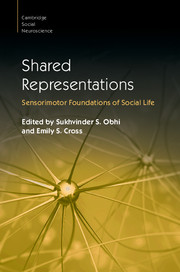Book contents
- Shared Representations
- Cambridge Social Neuroscience
- Shared Representations
- Copyright page
- Contents
- Figures
- Tables
- Boxes
- Contributors
- Preface
- Part I Foundations
- 1 What It Takes to Share a Task
- 2 Merged Minds
- 3 A New View of the Motor Cortex and Its Relation to Social Behavior
- 4 Beyond Action
- 5 Cognizance of the Neuroimaging Methods for Studying the Social Brain
- Part II Imitation and Mimicry
- Part III Thinking, Perceiving and Acting with Others
- Part IV Understanding Others
- Part V Learning and Development
- Part VI Shared Representations in Applied Contexts
- Index
- Plate Section (PDF Only)
- References
2 - Merged Minds
Integration of Bottom-Up and Top-Down Processes for Social Interactions
from Part I - Foundations
Published online by Cambridge University Press: 27 October 2016
- Shared Representations
- Cambridge Social Neuroscience
- Shared Representations
- Copyright page
- Contents
- Figures
- Tables
- Boxes
- Contributors
- Preface
- Part I Foundations
- 1 What It Takes to Share a Task
- 2 Merged Minds
- 3 A New View of the Motor Cortex and Its Relation to Social Behavior
- 4 Beyond Action
- 5 Cognizance of the Neuroimaging Methods for Studying the Social Brain
- Part II Imitation and Mimicry
- Part III Thinking, Perceiving and Acting with Others
- Part IV Understanding Others
- Part V Learning and Development
- Part VI Shared Representations in Applied Contexts
- Index
- Plate Section (PDF Only)
- References
Summary
Social cognition is composed of at least two major types of processes – bottom up and top down. Bottom-up processes are stimulus-driven, fairly automatic and fast. Top-down processes, on the other hand, require effort; they are deliberate and flexible. The mirror neuron system (MNS) is a recently discovered neural system that seems to map fairly well on bottom-up social processes. During social interactions, two individuals internally mirror each other’s actions via the MNS, hence connecting their bottom-up processes. At the same time, top-down mechanisms in each interacting person modulate the bottom-up activity. By doing so, each individual’s top-down mechanism also influences the other social agent via the bottom-up activity. Here, we discuss the two processes and how they interact with each other. We propose that the interplay between bottom-up and top-down processes creates a strong and dynamic link between the minds of two individuals and suggest a mechanistic model for how these processes may transform two minds into one functional social unit.
- Type
- Chapter
- Information
- Shared RepresentationsSensorimotor Foundations of Social Life, pp. 22 - 37Publisher: Cambridge University PressPrint publication year: 2016
References
- 1
- Cited by



